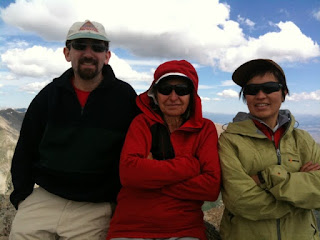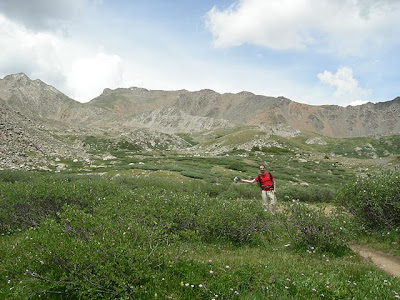This year’s hiking/camping trip with Carissa and Lin was to
Mount Harvard –- the third highest peak in Colorado at 14,420 feet (4,395 meters to those who insist on
Système-International d'Unités). It is the fourth highest peak in the 48 states behind California’s Mount Whitney, and Colorado’s Mount Elbert and Mount Massive.
You can read about last year’s Hiking trip on
this page and
this page (I apologize that the pictures are now defunct). Given that we failed to reach a summit last year, we decided on a simpler climb this year. Harvard is listed on the web as a clearly marked trail with little, if any,
scree to slog through, making it a high, but relatively easy climb.
Our intent was to hike a few miles into the park on Friday and set up camp in between Mount Harvard, Mount Yale, and Mount Columbia of the
Collegiate Range of the
Sawatch. Then on Saturday we would climb Harvard, and on Sunday we would do the slightly smaller Columbia, and also walk back out to the trailhead by nightfall.
As planned, our hike started on Friday with full packs. We walked a few miles up the trail (gently uphill) until roughly the place where the trail splits towards either Harvard or Columbia. We set up camp near the fork in the road. The campsite we found had clearly been used by many before – it was perhaps the softest and flattest dirt I’ve ever seen anywhere in any woods. Add to this a standard
thermarest air mattress and a thick sleeping bag, and quite frankly my tent was better than the beds I suffer through in many a hotel. I had no complaints whatsoever about comfort.

This was the view from our campsite. For a while we thought that the mountain in this picture is Mount Harvard, but it isn’t. I think it is known as Birthday Peak.
Carissa and Lin were dead-set on not eating freeze-dried camping food this year. So the first night’s dinner was curry-cous-cous with tofu and raisins and cashews and some broccoli soup. It was terrific. We had enough left-over cous-cous for about two days worth of breakfast and then some. After dinner we dove into our respective tents to try to escape the evening feeding frenzy of mosquitoes.
Another observation about Colorado mosquitoes:
Last year I noted that the Colorado breed of mosquitoes are a lot slower and dumber than the east coast variety. This year I will add the observation, that if they do manage to bite you, it itches far far less than in New Jersey. What sin did New Jersey commit in a past life to deserve fast, vicious, and itchy mosquitoes? Maybe they are a product of toxic waste --- sort of like Godzilla being created by nuclear waste.
Now back to hiking:
When hiking in Colorado, one should really be on the way down from the mountain by noon since thunderstorms tend to come in the afternoon and it is rather dangerous to be caught up high during a storm. Even given this restriction, it is actually possible to climb both up and down Harvard and then up and down Columbia all in one day, but only if you start
insanely early in the morning. During the night we heard a few climbing parties slogging by in the wee hours of the morning, and we assumed this was their intent. We, on the other hand, slept luxuriously late, ate our cous-cous breakfast, drank some
coffee, and started up the trail at around 7.
Having started the morning a fair distance up the trail already (and with no intent to do two mountains in one day) we did not feel pressed for time. As long as we kept slogging along at a slow pace, we felt we would make the summit easily by noon.
For several miles, the trail was an easy (albeit uphill) country walk. It was well marked and easy to follow and the terrain was about as smooth and clear as you could ask for. For this, we must thank all those people who don’t understand statistics very well. You see, upkeep of many trails in Colorado is paid for by the vast proceeds of the
Colorado lottery. It makes me almost want to buy a ticket even though I do understand statistics more or less. In fact one of the topics of conversation on our hike was Baysian reasoning. (But don’t get the idea it was all intellectual conversation --- we had long discussions of which
muppet videos were the best).

The smooth trail goes up the left of the picture above. Bear lake is on the right (Despite the name, we didn’t see any bears – but we were careful to hang all our food in
bear bags nonetheless). In the background is Mount Yale. Just behind Bear lake is the little peak which we could see from our campsite (possibly Birthday peak).
A bit higher up, the trail became much more steep. But for most of the way (again thanking the lottery) it was an extremely good trail --- like walking up a very long flight of stairs. Of course, once we got above about 12,000 feet, we found ourselves huffing and puffing quite a bit due to the thin air --- about 40% less oxygen than at sea level. Step-breathe-step-breathe, we made progress slowly but surely. Aside from all the huffing and puffing, the climb was not really all that difficult for most of the way.

Along the way we saw a bunch of random cute animals, including
Pikas and
Marmots which are both fundamentally rats, but are also insanely cute. That's a pika above and a marmot below (the fat one). I still expect him to start singing "I'm all right... don't have to worry 'bout me".

Near the very top, the trail suddenly turned into a boulder field and finally stopped being so wonderful. In Colorado, hiking trails are ranked into “classes” describing how technical they are (See
here for a description). Harvard is supposed to be a class-II climb, meaning that you rarely need to use your hands. However, over this boulder field (with some pretty exposed cliffs staring you in the face) it is probably class-III. Here's a picture of me a bit before the boulders really start getting serious.

Fortunately, the boulder field is quite short and we reached the summit with no real trouble – and well before noon. Here’s a picture of the three of us on the summit (Carissa is in front, Lin in the middle, and I’m hiding in back).

Some guy was on top smoking a cigarette and taking pictures with his iPhone --- and get this: he actually had reception on the top, so he was sending pictures as email. This photo was taken by his iPhone and sent directly to my Mom. Actually it is not such a bad picture. The picture would have been better if he could have backed up a few more feet to get more of a view, but then he would have fallen off a five hundred foot cliff.

In this final summit photo, I’m pointing to what I think is
Mount Oxford. We had discussed climbing Oxford as well, but decided against because the trail is not supposed to be well marked – maybe I’ll try it next year. Actually it turns out that Oxford is the mountain further to the right in the photo (over my left shoulder). The mountain I’m pointing to is probably
Mount Belford.

After a peanut butter lunch on top (jealously protecting our food from an eager Marmot), we started the long climb back down. From the top, the weather still looked clear so we had plenty of time to go slow downwards. (I climb down extremely slowly – Carissa and particularly Lin seem to have the genes of mountain goats and were able to go down at a much greater speed).
Despite my slower progress I nonetheless managed to twist my ankle on the way down. Crunch. Ugh. Fortunately it didn’t seem too bad and although it hurt a bit, it was no problem to keep walking on it.
As we got closer to the bottom, and the weather had still not turned foul, we felt free to linger even longer as we went along. Back down in the country fields we even took our time and sat by a nice creek for a while soaking our feet. At this point we had only about two relatively flat miles back to our campsite. Here I pose for a picture near the creek. Harvard is in the background.

Just as we were leaving the creek to head back to camp I commented “You know, Harvard was pretty easy!”. Well, unfortunately, it seems the mountain gods heard me. About a dozen steps after that my twisted ankle started making an unpleasant (and painful) crunching sound. Fortunately, Lin was carrying an Ace bandage which patched things up temporarily and I had little trouble getting back home. That will teach me not to insult the mountain gods.
So Harvard was easy, almost.
Back at camp, we started cooking dinner. This time it was mac-and-cheese with (dehydrated) tuna. Again yum. Although bringing real food is a bit more heavy than bringing all dehydrated hiking food, I’d vote that it is totally worth it.
While we had planned to climb Columbia the next day, considering the condition of my foot, this was not going to happen (at least for me). I was hoping that at the very least the ankle wouldn’t swell up too much, and I’d be able to hike out of the woods without too much problem the next day (being carried out would be rather humiliating). Carissa and Lin graciously decided that they would not climb Columbia without me (Actually it looked like a bit of a scree-fest anyway – the grapes were sour).
The next morning my foot was no better, but no worse either. So at least I would be able to walk out of the woods. We slept late, cooked breakfast (oatmeal), packed our tents and had a relatively easy hike back to the cars. Had a few beers by a river to celebrate our successful trip, and called it a day.







